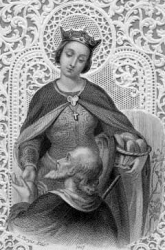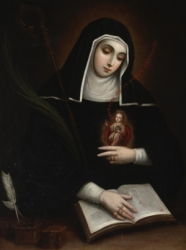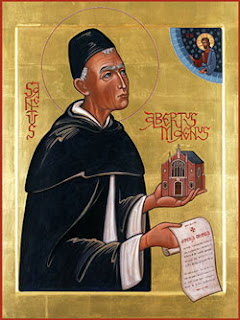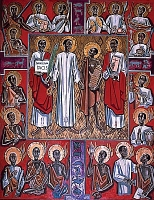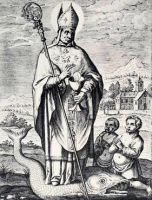St. Valentine and Dubatatius
Feastday: November 17
Were executed for their faith at Carthage. Sts. Valentine and Dubatatius feast day is November 17th.
St. Dionysius the Great of Alexandria
Feastday: November 17
Birth: 190
Death: 265
Image of St. Dionysius the Great of AlexandriaDIONYSIUS of Alexandria, Born in 190 A.D. as Dionysius the Great, I was Archbishop of Alexandria. I died in 265 A.D., 17 Nov.
This article is about the Bishop and Pope of Alexandria. For the topographical poet (sometimes known as Dionysius of Alexandria), see Dionysius Periegetes.
Dionysius the Great (Ancient Greek: Διονύσιος Ἀλεξανδρείας) was the 14th Pope and Patriarch of Alexandria from 28 December 248 until his death on 22 March 264. Most information known about him comes from his large surviving correspondence. Only one original letter survives to this day; the remaining letters are excerpted in the works of Eusebius.
Called "the Great" by Eusebius, Basil of Caesarea and others, he was characterized by the Catholic Encyclopedia as "undoubtedly, after St. Cyprian, the most eminent bishop of the third century... like St. Cyprian, less a great theologian than a great administrator."[3]
Early life
Dionysius was born to a wealthy polytheistic family sometime in the late 2nd, or early 3rd century. He spent most of his life reading books and carefully studying the traditions of polytheists. He converted to Christianity at a mature age and discussed his conversion experience with Philemon, a presbyter of Pope Sixtus II.[3] Dionysius converted to Christianity when he received a vision sent from God; in it he was commanded to vigorously study the heresies facing the Church so that he could refute them through doctrinal study. After his conversion, he joined the Catechetical School of Alexandria and was a student of Origen and Pope Heraclas. He eventually became leader of the school and presbyter of the church, succeeding Pope Heraclas in 231. Later he became Pope of the church of Alexandria & Patriarch of the See of St. Mark in 248 after the death of Pope Heraclas.[3]
Dionysius was more an able administrator than a great theologian.[3] Information on his work as Bishop of Alexandria is found in Dionysius' correspondence with other bishops and clergymen of the third century Catholic Church. Dionysius’ correspondences included interpretations on the Gospel of Luke, the Gospel of John and the Book of Revelation.
During 249, a major persecution was carried out in Alexandria by a polytheist mob, and hundreds were assaulted, stoned, burned or cut down on account of their refusal to deny their faith. Dionysius managed to survive this persecution and the civil war that followed. In January 250 the new emperor Decius issued a decree of legal persecution. Out of fear many Christians denied their faith by offering a token polytheist sacrifice, while others attempted to obtain false documents affirming their sacrifice. Others who refused to sacrifice faced public ridicule and shame among their family and friends, and, if found by the authorities, brutal torture and execution. Many fled from the city into the desert, where most succumbed to exposure, hunger, thirst, or attacks by bandits or wild animals.[4]
Dionysius himself was pursued by the prefect Aurelius Appius Sabinus, who had sent out an assassin to murder him on sight. Dionysius spent three days in hiding before departing on the fourth night of the Decian decree with his servants and other loyal brethren. After a brush with a group of soldiers, he managed to escape with two of his followers, and set up a residence in the Libyan desert until the end of the persecution the following year.[4]
He supported Pope Cornelius in the controversy of 251, arising when Novatian, a learned presbyter of the Church at Rome, set up a schismatic church with a rigorist position on the readmittance of Christians who had apostasized during the persecution. In opposition to Novatian's teaching, Dionysius ordered that the Eucharist should be refused to no one who asked it at the hour of death, even those who had previously lapsed.[5]
In 252 an outbreak of plague ravaged Alexandria, and Dionysius, along with other priests and deacons, took it upon themselves to assist the sick and dying.[4]
The persecutions subsided somewhat under Trebonianus Gallus, but were renewed under Valerian who replaced Gallus. Dionysius was imprisoned and then exiled. When Gallienus, took over the empire he released all the believers who were in prison and brought back those in exile. Gallienus wrote to Dionysius and the bishops a letter to assure their safety in opening the churches.[6]
During the debate with Pope Stephen and Cyprian, Dionysius supported the position of the Roman Bishop but he still supported the autonomy of the African churches.[7]
Legacy
Basil of Caesarea writes to Pope Damasus I about aid sent by Dionysius, to the church at Caesarea. This correspondence is cited by Pope Pius IX in his encyclical Praedecessores Nostros (On Aid For Ireland) of 25 March 1847
Saint Gregory Thaumaturgus
Also known as
• Gregory of Neo Caesarea
• Gregory of Neocaesarea
• Gregory of Pontus
• Gregory the Wonder Worker
• The Wonder Worker
• Theodorus
Profile
Born to a wealthy and distinguished pagan family. Trained in law and rhetoric in his youth. Brother-in-law to the Roman governor of Palestine. His father died when Theodore was age 14. The boy had originally planned to study at the law school in Beirut, but when he arrived at Caesarea with his brother-in-law's entourage, he encountered Origen, head of the catechetical school in Alexandria, Egypt. He and his brother Athenodorus each gave up the idea of law school, became students of Origen, and converted to Christianity; Theodore changed his name to Gregory. Studied philosophy and theology for seven years under Origen. Returned to Pontus c.238.
Bishop of Caesarea, a diocese with only 17 Christians when he arrived. Gregory converted most of his bishopric; tradition says there were only 17 pagans left at the time of his death. Instituted the celebration of martyrs, teachings about the saints, and celebration of saint feast days as a way to interest pagans in the Church. During the Decian persecutions c.250, he and his flock fled into the desert. Worked among the sick when the plague struck soon after, and with refugees during the invasion of Pontus by the Goths in 252. Attended the First Council of Antioch in 264 and 265. Opposed the heresies of Sabellianism and Tritheism. Used his legal training to help his parishioners, and settle disputes between them without taking their problems to the civil courts controlled by pagans. Oversaw the council that chose Saint Alexander the Charcoal Burner as the first bishop of Comana. Saint Macrina the Elder heard Gregory preach many times in her youth, and passed his wisdom onto her grandsons Saint Basil the Great and Saint Gregory of Nyssa. Noted theological writer.
As you might expect from some one surnamed the Wonder Worker, there were many miraculous events in Gregory's life.
• Saint Gregory of Nyssa writes that the Wonder-Worker was the first person known to receive a vision of the Theotokus. The Virgin and Saint John the Baptist appeared to him in a vision, and gave him what became a statement of doctrine on the Trinity.
• Gregory had the power of healing by laying on of his hands. Often the healing was so powerful that the patient was cured of his illness, and became a fervent convert on the spot.
• During the construction of a church for his growing flock, the builders ran into a problem with a huge buried boulder. Gregory ordered the rock to move out of the way of his church; it did.
• In order to stop the River Lycus from its frequent and damaging floods, Gregory planted his staff at a safe point near the river bank. He then prayed that the river would never rise past the staff. The staff took root, grew into a large tree, and the river never flooded past it again. This act led to his patronage against floods and flooding.
• Two local pagans, hearing that Gregory was a soft touch for money, decided to con the bishop. One lay beside the road where Gregory was travelling, and pretended to be dead. The other stopped the bishop, pleaded poverty, and asked for money to bury his dead friend. Gregory had no money with him, so he took off his cloak and threw it over the "dead" man, telling the "live" one to sell the cloak and use the funds. When Gregory had moved on, the "live" con-man found that his friend had died.
• Two brothers in Gregory's diocese had inherited a piece of land that contained a lake. Unable to decide how to divide the lake, the two settled on armed combat to settle the matter. On the night before the battle, Gregory prayed for a peaceful solution to the matter. The next morning the brothers found that the lake had dried up leaving easily dividable farm land.
• During Gregory's time in the desert during the Decian persecutions, an informer told the authorities where to find the bishop. Guards went to the site, but found nothing but two trees standing in isolation in the desert. The informer went back to the place and found that what the soldiers had seen as trees were actually Gregory and a deacon in prayer. This convinced the informer of the reality of Gregory's God, and he converted.
• When returning from the wilderness, Gregory had to seek shelter from a sudden and violent storm. The only structure nearby was a pagan temple. Gregory made the sign of the cross to purify the place, then spent the night there in prayer, waiting out the storm. The next morning, the pagan priest arrived to receive his morning oracles. The demons who had been masquerading as pagan gods advised him that they could not stay in the purified temple or near the holy man. The priest threatened to summon the anti-Christian authorities to arrest Gregory. The bishop wrote out a note reading "Gregory to Satan: Enter". With this "permission slip" in hand, the pagan priest was able to summon his demons again.
• The same pagan priest, realizing that his gods unquestioningly obeyed Gregory's single God, found the bishop and asked how it was done. Gregory taught the priest the truth of Christianity. Lacking faith, the priest asked for a sign of God's power. Gregory ordered a large rock to move from one place to another; it did. The priest immediately abandoned his old life, and eventually became a deacon under bishop Gregory. This ordering about of boulders led to Gregory's patronage against earthquakes.
Born
c.213 at Pontus, Asia Minor (in modern Turkey) as Theodorus
Died
• c.270 at Pontus, Asia Minor (in modern Turkey) of natural causes
• remains translated to Calabria, Italy
Patronage
• against earthquakes
• against floods
• desperate, forgotten, impossible or lost causes
Representation
• bishop driving demons out of a temple
• presenting a bishop's mitre to Saint Alexander the Charcoal Burner
Writings
• Metaphrase of the Book Of Ecclesiastes
• Sectional Confession of Faith
Saint Elizabeth of Hungary
ஹங்கேரியின் புனிதர் எலிசபெத்
கைம்பெண்/ மறைபணியாளர்:
(Widow and religious)
பிறப்பு: ஜூலை 7, 1207
போஸ்ஸோனி, ஹங்கேரி அரசு
(Pozsony, Kingdom of Hungary)
இறப்பு: நவம்பர் 17, 1231 (வயது 24)
மார்பர்க், புனித ரோம பேரரசு, (தற்போதைய ஜெர்மனி)
(Marburg, Holy Roman Empire (Modern-day, Germany)
சார்ந்துள்ள சமயம்/ சபை:
ரோமன் கத்தோலிக்க திருச்சபை
(Roman Catholic Church)
ஆங்கிலிக்கன் திருச்சபை
(Anglican Church)
லூதரன் திருச்சபை
(Lutheran Church)
புனிதர் பட்டம்: மே 27, 1235
திருத்தந்தை ஒன்பதாம் கிரகோரி
(Pope Gregory IX)
நினைவுத் திருவிழா: நவம்பர் 17
பாதுகாவல்:
மருத்துவமனைகள், செவிலியர், விதவையர், நாடு கடத்தும் தண்டனை, மணப்பெண், ரொட்டி தயாரிப்பாளர், வீடற்ற மக்கள், இறக்கும் குழந்தைகள், கைம்பெண்கள், சரிகை-தயாரிப்பாளர்கள், தூய ஃபிரான்சிஸின் மூன்றாம் நிலை சபை (Third Order of Saint Francis)
ஹங்கேரியின் புனிதர் எலிசபெத், "துரிங்கியாவின் புனிதர் எலிசபெத்" (Saint Elizabeth of Thuringia) என்றும் அறியப்படுபவர் ஆவார். “ஹங்கேரி அரசு” (Kingdom of Hungary), “துரிங்கியா” (Thuringia) மற்றும் “ஜெர்மனி” (Germany) ஆகிய நாடுகளின் இளவரசியான இவர், பெரிதும் போற்றப்படும் கத்தோலிக்க புனிதர் ஆவார். புனிதர் ஃபிரான்ஸிஸின் மூன்றாம் நிலை சபையின் (Third Order of St. Francis) ஆதிகால அங்கத்தினரான எலிசபெத், அச்சபையின் பாதுகாவலரும் ஆவார்.
ஹங்கேரி நாட்டின் அரசன் “இரண்டாம் ஆண்ட்ரூ” (King Andrew II of Hungary) இவரது தந்தை ஆவார். “மெரனியாவின் கேட்ரூ” (Gertrude of Merania) எலிசபெத்தின் தாயாராவர்.
தமது பதினான்கு வயதில் குறுநில மன்னரான “நான்காம் லூயிஸை” (Louis IV) திருமணம் செய்த எலிசபெத், இருபது வயதில் விதவையும் ஆனார். ஆறாவது சிலுவைப்போரில் (Sixth Crusade) பங்கேற்பதற்காக இத்தாலி பயணித்த லூயிஸ், வழியில் விஷக் காய்ச்சலால் பாதிக்கப்பட்டு 1227ம் ஆண்டு, செப்டம்பர் மாதம், 11ம் நாள், மரணமடைந்தார். தமது கணவரின் மரணத்தின் பின்னர், தமக்கான வரதட்சினை பணத்தை திரும்ப பெற்றுக்கொண்ட இவர், அந்த பணத்தில் ஓர் மருத்துவமனையை கட்டினார். தாமே சுயமாக நோயாளிகளுக்கு சேவை செய்ய ஆரம்பித்தார்.
ஓய்வு, ஆடம்பரம் மற்றும் சொகுசான வாழ்க்கை வாழ இயன்ற போதும், எலிசபெத் தவம் மற்றும் சந்நியாச வாழ்க்கையையே தேர்ந்தெடுத்தார். இவரது இந்த தேர்வு, ஐரோப்பா முழுவதுமுள்ள சாதாரண பொது மக்கள் இதயத்தில் அவருக்கு ஒரு இடத்தை பெற்றுத் தந்தது.
எலிசபெத், தமது குறுகிய கால வாழ்க்கையிலேயே, ஏழைகள் மற்றும் நோயுற்றோர் மீது அளவற்ற அன்பினை வெளிப்படுத்தினார்.
எலிசபெத்துக்கு வயது ஆக ஆக, பக்தியும் வளர்ந்து கொண்டிருந்தது. 1228ல், ஃபிரான்சிஸ்கன் சபையில் சேர்ந்தார். ஃபிரான்சிஸ்கன் சபை துறவிகளின் வழிகாட்டுதலின் பேரில், செப வாழ்வில் ஈடுபட்டார். ஏழைகளுக்கும் வறியவர்களுக்கும் உதவ தொடங்கினார். தினமும் தன் வாசலுக்கு வந்த நூற்றுக்கணக்கான ஏழைகளுக்கு உணவளித்தார். இதனால் அநேகர் இவருக்கு எதிரிகள் ஆயினர். இவருடைய கணவரது சகோதரி அக்னேஸ் இவரை முழு மூச்சுடன் வெறுத்தாள். அவளுடைய தாய் மிகுந்த உலகப் பற்றுக் கொண்டவள். அவளும் இவரை வெறுத்து அரண்மனையில் இருந்தவர்களுடன் சேர்ந்துகொண்டு எலிசபெத்தை நிந்தித்து வந்தார்கள். அவரை அரண்மனையிலிருந்தே துரத்தினார்கள்.
இவர் தமது உள்ளத்தை கடவுளிடமிருந்து அகற்றவில்லை. ஏழைகள் மீது இவர் எல்லையற்ற இரக்கம் கொண்டிருந்தார். "ஏழைகளின் அன்னை" என்றும் "நோயாளிகளின் ஊழியக்காரி" என்றும் இவரை அழைப்பார்கள். உலக மக்களின் அபிப்பிராயங்களை இவர் சட்டை செய்யவில்லை. தனக்கு இயல்பாய் உள்ள பொறுப்புகளை மேற்கொண்டு ஏழைகளிடமும் நோயாளிகளிடமும் கிறிஸ்து இயேசுவையே கண்டு அவர்களுக்கு சேவை செய்து வந்தார்.
நாட்டில் பெருவெள்ளம் வந்து பயிரை அளித்தது. இதனால் பஞ்சமும் கொள்ளை நோயும் வந்தன. ஒரு மருத்துவமனையைக் கட்டி அங்குபோய் தொழு நோயாளிகளுக்கு இவரே சிகிச்சை செய்தார். அப்பமும் இரசமும் இவரது மன்றாட்டால் பலுகியது. ஏழைகளுக்கு உதவி செய்ய அரச ஆடைகளையும், ஆபரணங்களையும் விற்றார்.
இவருடைய கணவரின் சகோதர்கள் அரண்மனையைக் கைப்பற்றிக் கொண்டு இவரை விரட்டி விட்டனர். இவர் பிரான்சிஸ்கன் துறவிகளின் ஆலயத்திற்குச் சென்று, இந்த துன்பத்திற்காக கடவுளுக்கு நன்றி செலுத்தி "தேதேயும்" என்னும் நன்றியறிதல் கீதத்தைப் பாடினார்.
தமது இருபத்துநான்கு வயதில் மரணமடைந்த எலிசபெத், கிறிஸ்தவ தொண்டிற்கு ஒரு அடையாளமாக ஆனார். தமது மரணத்தின் பின், விரைவில் புனிதராக அருட்பொழிவும் செய்யப்பட்டார்.
Also known as
• Elizabeth of Thuringia
• Elisabeth of...
Profile
Princess, the daughter of King Andrew of Hungary. Great-aunt of Saint Elizabeth of Portugal. She married Prince Louis of Thuringa at age 13. Built a hospital at the foot of the mountain on which her castle stood; tended to the sick herself. Her family and courtiers opposed this, but she insisted she could only follow Christ's teachings, not theirs. Once when she was taking food to the poor and sick, Prince Louis stopped her and looked under her mantle to see what she was carrying; the food had been miraculously changed to roses. Upon the death of Louis, Elizabeth sold all that she had, and worked to support her four children. Her gifts of bread to the poor, and of a large gift of grain to a famine stricken Germany, led to her patronage of bakers and related fields.
Born
1207 at Presburg, Hungary
Died
• 1231 at Marburg, Germany of natural causes
• her relics, including her skull wearing a gold crown she had worn in life, are preserved at the convent of Saint Elizabeth in Vienna, Austria
Canonized
27 May 1235 by Pope Gregory IX at Perugia, Italy
Patronage
• against in-law problems • against the death of children • against toothache • bakers • beggars • brides • charitable societies • charitable workers • charities • countesses • exiles • falsely accused people • hoboes • homeless people • hospitals • lacemakers • lace workers • nursing homes • nursing services • people ridiculed for their piety • tertiaries • tramps • widows • Sisters of Mercy • Teutonic Knights • diocese of Erfurt, Germany • archdiocese of Jaro, Philippines • Jalzabet, Croatia
Representation
• woman wearing a crown and tending to beggars • woman wearing a crown, carrying a load of roses in her apron or mantle
Saint Hugh of Lincoln
Also known as
• Hugh of Avalon
• Hugh of Burgundy
Profile
Born to the nobility, the son of William, Lord of Avalon. His mother Anna died when he was eight, and he was raised and educated at a convent at Villard-Benoit in France. Monk at 15. Deacon at 19. Prior of a monastery at Saint-Maxim. Joined the Carthusians in 1160. Ordained in 1165. In 1175 he became abbot of the first English Carthusian monastery, which was built by King Henry II as part of his penance for the murder of Thomas Becket.
His reputation for holiness spread through England, and attracted many to the monastery. He admonished Henry for keeping dioceses vacant in order to keep their income for the throne. He resisted the appointment, but was made bishop of Lincoln on 21 September 1181. Restored clerical discipline in his see. Rebuilt the Lincoln cathedral, destroyed by earthquake in 1185.
Hugh denounced the mass persecution of Jews in England in 1190-91, repeatedly facing down armed mobs, making them release their victims. Diplomat to France for King John in 1199, a trip that ruined his health. While attending a national council in London a few months later, he was stricken with an unnamed ailment, and died two months later.
Born
1135 at Avalon Castle, Burgundy, France
Died
• 16 November 1200 at London, England of natural causes
• buried in the Lincoln Cathedral
Canonized
• 18 February 1220 by Pope Honorius III
• first canonized Carthusian
Patronage
• sick children
• sick people
• swans
Representation
• angel protecting him from lightning
• bearded bishop giving a blessing
• Carthusian surrounded by seven stars
• Carthusian with a swan
• chalice
• bishop with a swan
• swan; there is a story of him being befriended by a swan which would guard Hugh when he slept
• helping to build the Lincoln Cathedral
• man with a swan at his death bed
• raising a dead child to life
Saint Florinus of Remüs
Also known as
• Florinus of Chur
• Florinus of Finsgowe
• Florinus of Matsch
• Florinus of Mazia
• Florinus of Ramosch
• Florinus of Val Venosta
• Florinus of Vinschgau
• Florinus of Vnuost
• Florin, Florian
Additional Memorials
• 7 August (translation of relics to Chur, Switzerland)
• 18 December (translation of relics to the Trier, Germany)
Profile
Legend says that his father was a Saxon, his mother a Jew who converted to Christianity; the two met while they were both on pilgrimage to Rome, Italy, they married, and then settled in the Val Venosta in the Italian Tyrol region. Educated by Father Alexander at the parish of Saint Peter in Remüs (modern Ramosch), Switzerland; previous minister's there include Saint Othmar of Saint Gall. Ordained in Unterengadin, Switzerland, he served as the parish priest at Saint Peter's in Remüs, living like a hermit and caring for the poor. Miracle worker who turned water to wine which he then gave away to the poor.
Born
late 8th century Val Venosta, Italy
Died
• c.856 at Remüs (modern Ramosch), Switzerland of natural causes
• buried in the graveyard of the parish of Saint Peter in Remüs
• some relics enshrined in Koblenz, Germany in 950
• some relics enshrined in Regensburg, Germany
Representation
• book
• chunk of limestone
• wine jug, pitcher, bottle or pot (referring to the miracle of turning water to wine)
Patronage
• Chur, Switzerland, diocese of
• Vaduz, Liechtenstein, diocese of
• Lower Engadine, Switzerland
• Val Venosta, Italy
Saint Hilda of Whitby
Also known as
Hild of Whitby
Profile
Daughter of Hereric and Breguswith. Sister of Saint Hereswitha. Grand-niece of King Saint Edwin of Northumbria. Baptized in 627 at age thirteen by Saint Paulinus of York. Lived as a single lay woman until age 33 when she became a Benedictine nun at the monastery of Chelles in France. Abbess at Hartepool, Northumberland, England. Abbess of the double monastery of Whitby, Streaneshalch. Abbess to Saint Wilfrid of York, Saint John of Beverley, and three other bishops. Patroness and supporter of learning and culture, including the work of the poet Caedmon.
Hilda and her houses followed the Celtic liturgy and rule, but many houses had adopted the continental Benedictine rule, and the Roman liturgy. Hilda convened a conference in 664 to help settle one a single rule. When the conference settled on the Roman and Benedictine, they were adopted throughout England, and Hilda insured the observance of her houses.
Born
614 at Northumbria, England
Died
680 of natural causes
Representation
• being carried to heaven by the angels
• holding Whitby abbey in her hands with a crown on her head or at her feet
• stopping wild birds from stealing a corn crop
• turning serpents into stone
Saint Aignan of Orléans
Also known as
Agnan, Anian, Anianus
Profile
Born to the nobility, his parents were Hungarians who had fled to the Dauphine area of modern France to escape Arian persecutions. Lived as a hermit in a cave. Spiritual student of Saint Evurtius of Orléans. Priest. Monk. Abbot of the Saint Laurence Abbey in Orléans, France. Bishop of Orléans. Organized the defense of Orléans during the invasion of Attila the Hun, met with Attila and prevented him attacking the city in 451.
Born
358 at Vienne, France
Died
• 453 of natural causes
• in the 10th-century King Robert built a church in Orléans, France in Aignan's honour, and his relics were enshrined in it
• relics destroyed by Calvinists in the 16th century
Patronage
Diocese of Orléans, France
Representation
praying on the walls of Orléans, France with an army in the field near the city
Blessed Yosafat Kotsylovskyi
Also known as
• Josaphat Kocylovskyj
• Josaphat Kotsylovsky
Additional Memorial
27 June as one of the Martyrs Killed Under Communist Regimes in Eastern Europe
Profile
Greek Catholic. Studied theology in Rome, graduating in 1907. Ordained on 9 October 1907. Vice-rector and professor of theology at the Stanislaviv, Ukraine seminary. Entered the Basilian novitiate on 2 October 1911. Bishop of Premeshyl, Poland on 23 September 1917. Imprisoned for his faith by Polish authorities in September 1945. Died in prison. One of the Martyrs Killed Under Communist Regimes in Eastern Europe.
Born
3 March 1876 at Pakoshivka, Lemkiv District, Ukraine
Died
martyred on 17 November 1947 in prison in Kiev, Ukraine
Beatified
27 June 2001 by Pope John Paul II in Ukraine
Blessed Salomea of Galicia
அருளாளர்_சலோமியா (1211-1268)
நவம்பர் 17
இவர் (#Bl_Salomea_Of_Poland) போலந்து நாட்டைச் சார்ந்தவர். இவரது தந்தை போலந்தை ஆண்ட லஸ்ஜெக் என்பவர் ஆவார்.
ஒருசில அரசியல் காரணங்களுக்காக இவருக்கு மூன்றாம் வயதிலேயே அங்கேரி நாட்டு இளவரசரோடு மண ஒப்பந்தம் நடைபெற்று, ஏழாம் வயதில் திருமணம் நடைபெற்றது.
திருமணத்திற்கு பிறகு இவர் தனது கன்னிமையை கடவுளுக்கு ஒப்புக் கொடுத்து வாழ்ந்து வந்தார். 1245 ஆம் ஆண்டு இவரது கணவர் ஒரு போரில் இறந்துவிட, இவர் புனித கிளாரா சபையில் சேர்ந்து துறவியானார்.
துறவியான ஒரு சில ஆண்டுகளிலேயே இவருடைய எடுத்துக்காட்டாக வாழ்க்கையால் ஜவிசோஸ்ட் என்ற இடத்தில் இருந்த துறவுமடத்தின் தலைவியாக உயர்த்தப்பட்டார்.
இவ்வாறு இல்லறத்தில் தூய்மையாகவும், துறவறத்தில் எடுத்துக்காட்டாகவும் வாழ்ந்த இவர், 1268 ஆம் ஆண்டு இறையடி சேர்ந்தார். இவருக்கு 1673 ஆம் ஆண்டு திருத்தந்தை பத்தாம் கிளமெண்ட்டால் புனிதர் பட்டம் கொடுக்கப்பட்டது.
Also known as
• Salomea of Poland
• Salomea of Polonia
• Salome...
Profile
Born to the nobility. Married in her youth to Colomon, a prince of Hungary. Widowed, Salomea followed a call to religious life; she became a Franciscan Poor Clare nun, founded a monastery, and eventually serving as its abbess.
Born
13th century Galicia (in modern Poland)
Died
• 17 November 1268 near Cracow, Poland of natural causes
• relics enshrined in Cracow
Beatified
1673 by Pope Clement X (cultus confirmation)
Saint Gregory of Tours
Also known as
George Florentius
Profile
Born to the Gallic nobility; great-nephew of Saint Eustadius. Friend of Saint Magnericus and Saint Senoch. While on pilgrimage to the shrine of Saint Martin of Tours, his obvious piety led to his being chosen bishop of Tours, France in 573, taking the name Gregory on his ordination. An excellent bishop for 20 years; Pope Saint Gregory the Great thought highly of him. Historian and writer; his works are our best historical source for the Merovingian period.
Born
540 at Auvergne, France as George Florentius
Died
594 of natural causes
Saint Juan del Castillo Rodríguez
Profile
Jesuit priest. One of the Jesuit Martyrs of Paraguay.
Born
14 September 1595 in Belmonte, Cuenca, Spain
Died
stoned to death on 17 November 1628 in Ijuí, Rio Grande do Sul, Paraguay (in modern Brazil)
Canonized
16 May 1988 by Pope John Paul II
Patronage
native traditions
Saint Giacinto Ansalone
Also known as
• Giordano Ansaloni
• Giordano of Saint Stephen
• Hyacinth Jordan Ansalone
Profile
Dominican priest. Studying in Palermo, Italy and Salamanca, Spain. Missionary to Mexico, the Philippines and Japan. As he travelled, he wrote a book on the lives of Dominican saints. Martyr.
Born
1 November 1598 in San Stefano Quisquina, Agrigento, Italy
Died
17 November 1634 in Nishizaka, Nagasaki, Japan
Canonized
18 October 1987 by Pope John Paul II
Patronage
Santo Stefano Quisquina, Italy
Saint Lazarus Zographos
Also known as
• Lazarus the Painter
• Lazarus of Constantinople
• Lazzaro...
Profile
Monk at Constantinople. Skilled painter of icons. Opposed the Iconoclasts under emperor Theophilus. He defended sacred images, and restored those that were defaced by Iconoclasts. For his work he was arrested and tortured. When the Iconoclasts fell from power, Lazarus was released and given a prominent place in the new regime, eventually becoming ambassador to Rome.
Died
867 of natural causes
Name Meaning
the painter = zographos
Saint Acisclus
Also known as
Aciscle, Acisclo, Ascylus, Iscle, Ocysellus
Profile
Brother of Saint Victoria of Cordoba. Martyred in the persecutions of Diocletian. After their deaths, their home was turned into a church. They have an office in the Mozabic Liturgy, and devotion to them is widespread throughout Spain and France.
Born
at Cordoba, Spain
Died
beheaded in 304
Patronage
Cordoba, Spain
Representation
• with Saint Victoria
• wearing a crown of roses
Blessed Sébastien-Loup Hunot
Profile
Priest in the Archdiocese of Sens, France. Imprisoned on a ship in the harbor of Rochefort, France and left to die during the anti-Catholic persecutions of the French Revolution. One of the Martyrs of the Hulks of Rochefort.
Born
7 August 1745 in Brienon-l'Archevêque, Yonne, France
Died
17 November 1794 aboard the prison ship Washington, in Rochefort, Charente-Maritime, France
Beatified
1 October 1995 by Pope John Paul II
Saint Victoria of Cordoba
Profile
Sister of Saint Acisclus. Martyred in the persecutions of Diocletian. After their deaths, their home was turned into a church. They have an office in the Mozabic Liturgy, and devotion to them is widespread throughout Spain and France.
Born
at Cordoba, Spain
Died
shot with arrows in 304
Representation
• crowned with roses
• in the company of Saint Acisclus
Patronage
Cordoba, Spain
Saint Thomas Hioji Nishi Rokuzaemon
Also known as
Father Thomas of Saint Hyacinth
Profile
Dominican missionary priest, first Formosa and then Japan. Tortured and martyred in the persecutions of Tokugawa Yemitsu.
Born
1590 in Hirado, Nagasaki, Japan
Died
17 November 1634 in Nishizaka, Nagasaki, Japan
Canonized
18 October 1987 by Pope John Paul II
Saint Hugh of Novara
Also known as
• Hugo of Nucaria
• Hugo of Noaria
• Ugo, Hugh
Additional Memorial
16 August in Novara, Sicily
Profile
Cistercian Benedictine monk. Spiritual student of Saint Bernard of Clairvaux. Served as first abbot at the abbey in Novara, Sicily.
Born
French
Died
c.1170 of natural causes
Patronage
Bovara, Sicily
Saint Eugene of Florence
Profile
Spiritual student of Saint Ambrose of Milan. Deacon in Florence, Italy, working with Saint Zenobius of Florence.
Died
422
Saint Namasius of Vienne
Also known as
Naamat, Namaise, Namacio, Namat, Namatius
Profile
Bishop of Vienne, France.
Died
c.599
Saint Zacchaeus of Palestine
Profile
Tortured and martyred in the persecutions of Diocletian.
Died
beheaded c.302 in Palestine
Saint Alphaeus of Palestine
Profile
Tortured and martyred in the persecutions of Diocletian.
Died
beheaded c.302 in Palestine
Martyred in the Spanish Civil War
Thousands of people were murdered in the anti-Catholic persecutions of the Spanish Civil War from 1934 to 1939. I have pages on each of them, but in most cases I have only found very minimal information. They are available on the CatholicSaints.Info site through these links:
• Blessed Eusebio Roldán Vielva
• Blessed Josefa Gironés Arteta
• Blessed Lorenza Díaz Bolaños





